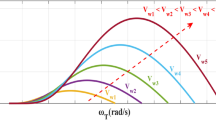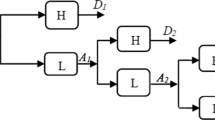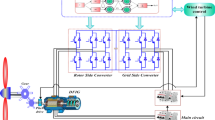Abstract
During normal operation, the doubly-fed induction generator (DFIG) generates certain range of reactive power. The DFIG based wind farm can participate in reactive power control of grid as a reactive power supply. In order to get a more stable input wind speed of the DFIG, wavelet multi-resolution analysis method is used. This paper proposes a kind of power dispatch model which considers a learning mechanism of minimum copper loss of all DFIGs in wind farm as an objective function. An active power and reactive power allocation optimization model is established. This power dispatch model makes the working condition of DFIGs and the PCC running in the optimum state. The active power and reactive power generated by wind farm satisfy the power gird requirements of both active power and reactive power. The advantage of the proposed method is verified by a case study which successfully demonstrates the learning mechanism.





Similar content being viewed by others
References
Xiangdong ZHU (2012) Current China’s wind power abandon wind. Energy Energy Conserv (10):30–67
Li W, Truong D (2013) Stability enhancement of a power system with a PMSG-based and a DFIG-based offshore wind farm using a SVC with an adaptive-network-based fuzzy inference system. IEEE Trans Ind Electron 60(7):2799–2807
Ji F, Zhou L, Yao G, Chen C (2005) Static var compensator based on the method of synchronous symmetrical component. Proc CSEE 25(6):27–32
Sun S, Cheng Y, Han D, Zhao P, Mao Q (2013) Research on improving low voltage ride through of a wind farm by SVC. China Electric Power (Technology Edition), (1):47–51
Wang C, Liang J, Zhang L, Han X (2010) Reactive power and voltage control strategy for wind farm based on STATCOM. Proc CSEE 30(25):23–28
Han C, Huang AQ, Baran ME, Bhattacharya S, Litzenberger W, Anderson L, Johnson AL, Edris A (2008) STATCOM impact study on the integration of a large wind farm into a weak loop power system. IEEE Trans Energy Convers 23(1):226–233
Xu Q, Zhang H, Zhou C, Jiang T (2011) Low-voltage ride-through capability for wind generators based on dynamic voltage restorers. J North China Electr Power Univ (Natural Science Edition) 38(5):6–10
Lang Y, Zhang X, Dianguo X, Ma H, Hadianmrei SR (2007) Reactive power analysis and control of double fed induction generator wind farm. Proc CSEE 27(9):77–82
Li R, Tang F, Liu Y, Wang T, Jia J, Cheng L (2012) A new scheme of reactive power compensation and voltage control for DFIG based wind farm. Proceedings of the CSEE 32(19):16–23 180
Zhang X, Liu Y, Hai Y, Dianguo X (2010) Improved voltage control strategy of double-fed induction generators wind farm in distribution networks. Proc CSEE 30(7):29–35
Zhu X, Zhang Y, Gao K, Li Q, Xizhou D, Liu T (2009) Research on the compensation of reactive power for wind farms. Power Syst Prot Control 37(16):68–72
Tapia A, Tapia G, Ostolaza JX (2004) Reactive power control of wind farms for voltage control application. Renew Energy 29:377–392
Small K, Roth D (2010) Margin-based active learning for structured predictions. Int J Mach Learn Cybern 1(1–4):3–25
Tang Y, Yan P, Yuan Y, Li X (2011) Single-image super-resolution via local learning. Int J Mach Learn Cybern 2(1):15–23
Li J, Han G, Wen J, Gao X (2011) Robust tensor subspace learning for anomaly detection. Int J Mach Learn Cybern 2(2):89–98
Tang YY, You XG (2003) Skeletonization of ribbon-like shapes based on a new wavelet function. IEEE Trans Pattern Anal Mach Intell 25(9):1118–1133
Tang YY, Yang LH, Liu JM (2000) Characterization of Dirac-structure edges with wavelet transform. IEEE Trans Syst Man Cybern Part B 30(1):93–109
Tang YY, Li BF, Ma H, Liu JM (1998) Ring-projection-wavelet-fractal signatures: A novel approach to feature extraction. IEEE Trans Circuits Syst II Analog Digital Signal Process 45(8):1130–1134
Tang YY, Yang F, Liu JM (2001) Basic processes of chinese character based on cubic B-spline wavelet transform. IEEE Trans Pattern Anal Mach Intell 23(12):1443–1448
Tang YY, Ma H, Liu JM, Li BF, Xi DH (1997) Multiresolution analysis in extraction of reference lines from documents with gray level background. IEEE Trans Pattern Anal Mach Intell 19(8):921–926
Chacko BP, Krishnan VRV, Raju G, Anto PB (2012) Handwritten character recognition using wavelet energy and extreme learning machine. Int J Mach Learn Cybern 3(2):149–161
Kundu MK, Chowdhury M, Banerjee M (2012) Interactive image retrieval using M-band wavelet, earth mover’s distance and fuzzy relevance feedback. Int J Mach Learn Cybernet 3(4):285–296. doi:10.1007/s13042-011-0062-8
Kathirvalavakumar T, Ponmalar E (2013) Self organizing map and wavelet based image compression. Int J Mach Learn Cybernet 4(4):319–326
Mehta R, Rajpal N, Vishwakarma VP (2015) A robust and efficient image watermarking scheme based on Lagrangian SVR and lifting wavelet transform. Int J Mach Learn Cybernet. doi:10.1007/s13042-015-0331-z
Mehta R, Rajpal N, Vishwakarma VP (2015) Robust image watermarking scheme in lifting wavelet domain using GA-LSVR hybridization. Int J Mach Learn Cybernet. doi:10.1007/s13042-015-0329-6
Wei X, Qiu X, Li X, Zhang Z (2010) Multi-objective reactive power optimization in power system with wind farm. Power Syst Prot Control 38(17):107–111
Bin W, Lang Y, Zargari N, Kouro S (2012) Power conversion and control of wind energy systems. China machine press, Beijing
Acknowledgments
This paper is supported by the Fundamental Research Funds for the Central Universities of China (2014XS08).
Author information
Authors and Affiliations
Corresponding author
Rights and permissions
About this article
Cite this article
Wang, Z., Zhang, L., Li, G. et al. Active power and reactive power dispatch of wind farm based on wavelet learning. Int. J. Mach. Learn. & Cyber. 9, 217–223 (2018). https://doi.org/10.1007/s13042-015-0358-1
Received:
Accepted:
Published:
Issue Date:
DOI: https://doi.org/10.1007/s13042-015-0358-1




